

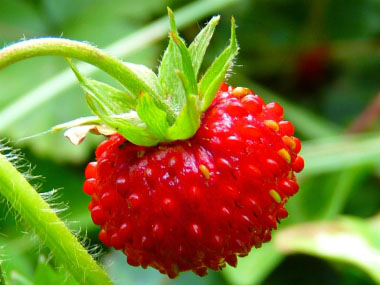
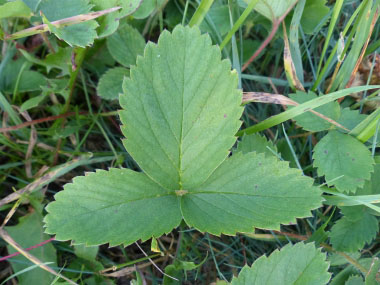
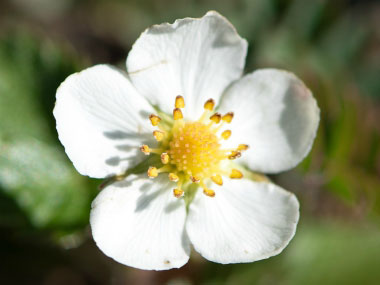
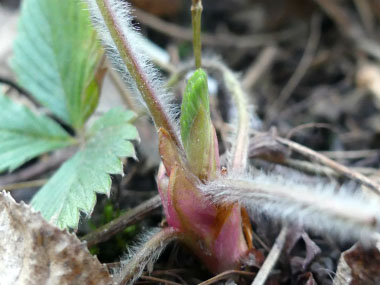
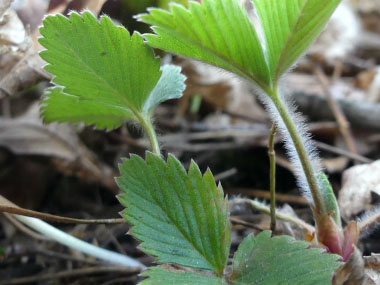
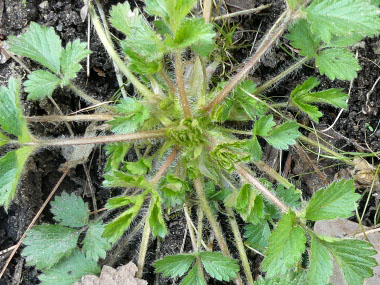
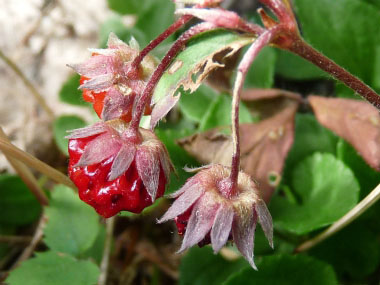
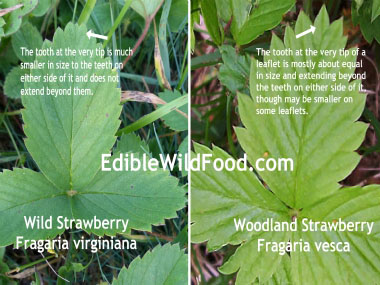
To support our efforts please browse our store (books with health benefits, etc.).
Is wild strawberry edible? Yes it is, but do you know which species you are eating? Oftentimes people get wild and woodland strawberries confused. The wild strawberry listed here is Fragaria virginiana. It is an herbaceous perennial plant native to North America. Wild strawberry is in the Rosaceae family and is a "producer"; it uses photosynthesis to convert the sun’s energy into glucose. It also converts carbon dioxide to oxygen, which is important for all organisms. Interestingly, many types of wildlife eats it’s central portion of the flower, which is known as the receptacle. Cultivated strawberries found in stores are hybrid crosses between Fragaria virginiana (native to North America) and Fragaria chiloensis (native to western coastal South America including Chile).
Distinguishing Features
Wild strawberries are very to spot as their leaves have toothed edges and hairy undersides. The white flowers have five petals and a golden centre; and the distinctive red fruit look like cultivated strawberries with tiny seeds on the outside. The wild strawberry produces long hairy runners up to 5 cm (2”) long, which re-root to form plantlets. Theses runners are often dull red colored. (Producing runners is the main way that the wild strawberry reproduces since seed germination is poor.)
Flowers
Clusters of white flowers, usually several blooming at one time (April to June) and sometimes nodding, occur at the end of a stem which is usually shorter than the height of surrounding leaves. Flowers are 1 to 2 cm (½ to ¾”) wide with 5 round to oval petals. They have about 20 yellow stamens surrounding a yellowish center, and 5 sharply pointed sepals as long as or shorter than the petals. Multiple small leaflet-like bracts are often present where the flower stalks diverge at the top of the stem. Flowers produce small, globe-shaped red strawberries. The tiny seeds (achenes) attached in shallow pits on the berry (drupe) surface.
 Fields
of Nutrition has medicinal benefits and vitamin/mineral content of Wild Strawberry.
Fields
of Nutrition has medicinal benefits and vitamin/mineral content of Wild Strawberry.
Leaves
This plant typically consists of several trifoliate leaves at the tips of long hairy petioles. The leaves are green (sometimes bluish-green) on top and pale green underneath. Each mature leaflet can reach to about 7 cm (3”) long and 4 cm (1.5”) wide; however, they are generally smaller. The leaflets are oval shaped and have coarse teeth along the edge except near the bottom. The terminal tooth (at the very tip) is much smaller in size to the teeth on either side of it and does not extend beyond them. Stems are above ground runners (stolons) that root at tips from which a crown of leaves emerge.
Height
Typically this plant grows between 5 and 15 cm (1 to 5”) tall.
Habitat
Habitats include moist black soil prairies, openings and edges of woodlands, savannas, limestone glades, and in open forests. When it is in open prairies it is usually not very far from woodlands. The wild strawberry commonly lives under full or partial sun. It is able to tolerate shade since it develops early in the spring. It prefers rich soil and moist conditions. It is able to grow in disturbed areas.
Edible Parts
Leaves, flowers and fruit are edible. The fruit is often hard to find as they are a tasty treat for wildlife. Many say that the taste of the wild strawberry is by far superior to the cultivated berry due to its sweet flavour. Leaves can be used in teas, salads, or in sandwiches.
Other Name
Scarlet Strawberry.
Similar Plants
Woodland Strawberry.
Recipes
Winter Survival Food Handbook

PDF Plant Magazines
Types of Wild Food
Geographic Zones Seasons
Disclaimer
EdibleWildFood.com is informational in nature. While we strive to be 100% accurate, it is solely up to the reader to ensure proper plant identification. Some wild plants are poisonous or can have serious adverse health effects.
We are not health professionals, medical doctors, nor are we nutritionists. It is up to the reader to verify nutritional information and health benefits with qualified professionals for all edible plants listed in this web site. Please click here for more information.
Why Edible Wild Food?
- Food costs are rising
- Free, wild food is readily abundant
- Wild food adds nutrition to your diet
- Wild food can help treat various medical conditions





